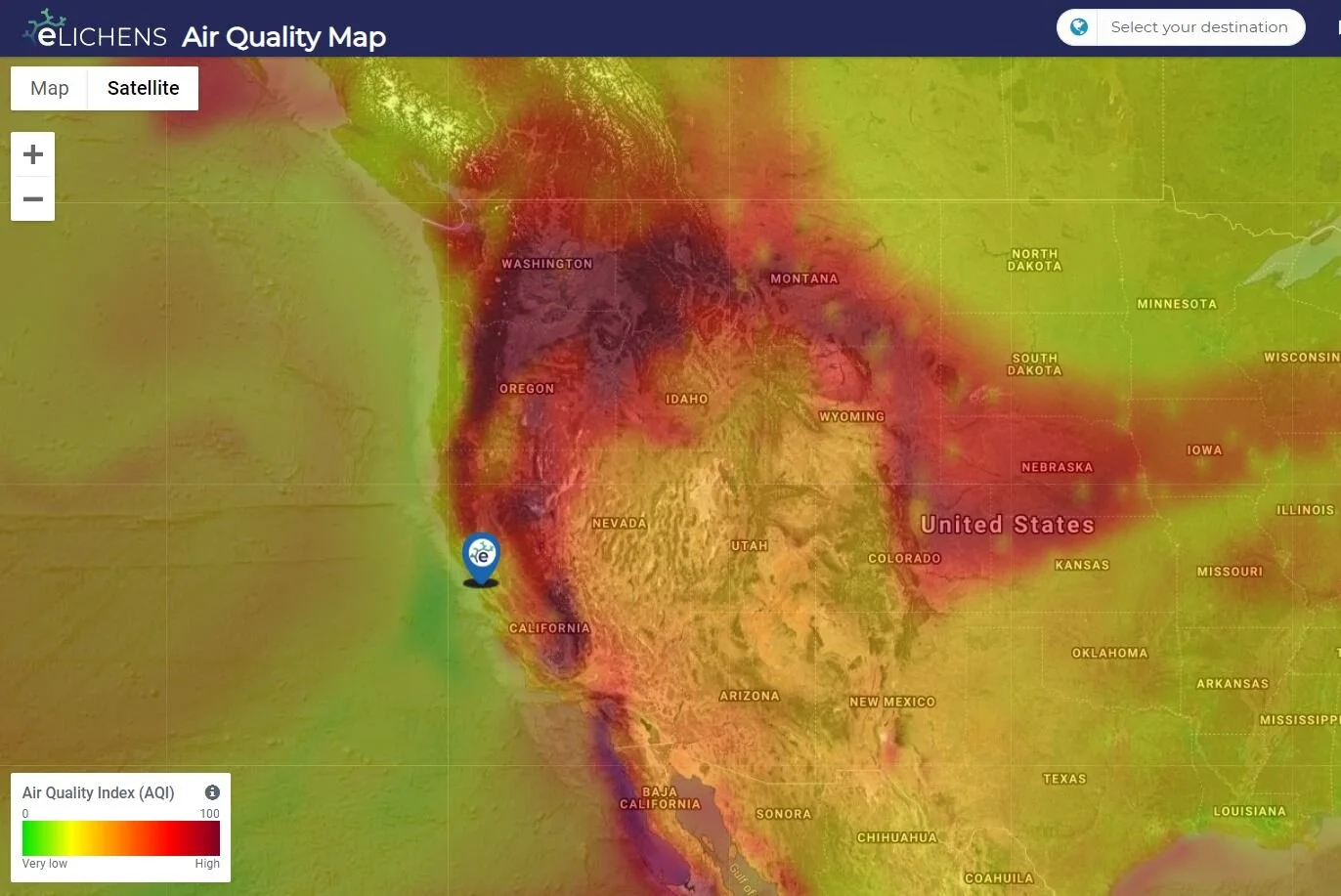Impact of COVID-19 on air quality in San Francisco
In response to the global COVID-19 outbreak, San Francisco county has enforced measures to limit the spread in the area. Among others, a shelter-in-place order has been declared for all residents, starting on March 17th.
In this report, we want to assess the impact on air quality (AQ) of such containment measures since these have a direct effect on road traffic which is a major source of pollutants emission.
To do so, in collaboration with Daikin Open Innovation Lab, eLichens has launched (early 2020) its real-time air quality maps technology at San Francisco: 20 eLos (eLichens outdoor air quality stations) have been deployed, which resort to advanced AQ sensors (measuring NO2, O3, PM10, PM2.5 and other ambient parameters), in combination with a high resolution dispersion model.
These high-resolution AQ forecasts make it possible to analyse the evolution of air quality in San Francisco, before and after the shelter-in-place order.
We will focus on NO2, O3 and PM2.5 concentrations:
NO2: nitrogen dioxide forms from emissions from cars, trucks and buses, power plants and off-road equipment. Exposure over short periods of time can aggravate existing respiratory diseases, and longer exposures may contribute to the development of asthma and respiratory infections. People with asthma, children and the elderly are at greater risk when exposed to NO2.
O3: the ozone molecule is harmful for outdoor air quality, if outside of the ozone layer. At surface level, ozone forms from chemical reactions between nitrogen oxides and volatile organic compounds (VOC). It can result in conditions such as chest pain, cough, throat irritation and airway inflammation. Furthermore, it can reduce lung function and worsen bronchitis, emphysema, and asthma. Ozone also affects sensitive vegetation and ecosystems.
PM2.5: atmospheric particulate matter (PM), also known as atmospheric aerosol particles, are complex mixtures of small solid and liquid matter that get into the air. PM2.5 refers to those particles with a diameter of 2.5 micrometers or less. They can cause serious heart and lungs problems when inhaled. They have been classified as group 1 carcinogens by the International Agency for Research on Cancer (IARC).
The shelter-in-place order occurred on March 17th. In order to clearly visualize the effect of this order, two periods of time were investigated in this study: March 1st to March 15th (before containment of population – Period 1) and March 24th to April 8th (after containment of population – Period 2). Average concentrations measured by eLichens’ eLos deployed in the area are considered, as well as time series of hourly and daily concentrations.
1. A 43% drop in NO2 concentrations as a result of the decrease of traffic
Between Period 1 and Period 2, an important drop of 43.1% in NO2 average concentrations can be seen in San Francisco (Figure A1 and Table 1, from 21.4 µg·m-3 to 12.2 µg·m-3). This is almost certainly due to the decrease in traffic. This decrease in NO2 concentrations comes with a slight increase of 14.3% in O3 concentrations (Figure A2 and Table 1, from 62.7 µg·m-3 to 72.1 µg·m-3). This phenomenon (decrease in NO2 concentrations and joint raise in O3 concentrations) has been widely observed in other cities and can be explained by the complex chemical reactions between nitrogen oxides and ozone. Indeed, O3 is a secondary pollutant (not emitted directly into the atmosphere) that is produced by chemical reactions between NO2, hydrocarbons, and sunlight. In urban areas, traffic usually produces high levels of nitrogen oxides (NO, NO2) and the level of O3 is usually lower there than in the surrounding rural areas. Also, as the energy to initiate the formation of O3 comes from the sun, peaks in O3 concentrations usually occur during hot and sunny summer days. Therefore, the increase in O3 observed in San Francisco likely results from the associated decrease in NO2.
Table 1: Evolution in pollutants concentrations between Period 1 (March 1st - March 15th) and Period 2 (March 24th - April 8th) extracted from the eLichens eLos stations network, in San Francisco.
1.1 A clear decrease in NO2 is observed during working days
The complete hourly time series is reported in Figure 1 for NO2 and Figure 2 for O3. During Period 1, a clear distinction between working days and weekend can be seen on the NO2 concentrations, with weekend having the lowest NO2 levels. A first decrease occurs after the first 2 containment measures were announced (first companies sending employees to work from home, partial closing of private schools). As soon as the shelter-in-place order took place, a negative trend appeared, with almost no variations between working days and weekend afterwards. It illustrates the respect of the containment order by most of the population. As explained above, O3 concentrations exhibit an opposite trend.
Figure 1: Evolution of NO2 concentrations measured by all 20 eLichens eLos stations deployed at San Francisco.
Figure 2: Evolution of O3 concentrations measured by all 20 eLichens eLos stations deployed at San Francisco.
1.2 Decrease in NO2 is even more important around the main axes
Pollution is not homogeneously distributed in an urban area. The high spatial resolution of eLichens’ air quality maps allows to investigate the major trends, street type by street type. For both periods, high NO2 concentrations are visible around the main road axes (Figure A1, left), but a decrease is clearly visible between the two periods (Figure A1, right). We highlight these spatial differences in variations of average NO2 and O3 concentrations between the two periods in Figure 3. The changes in NO2 concentrations by street types are reported on Table 2. The decrease in NO2 concentrations is 20.6% more important in streets with the highest usual traffic profile (motorways and primary streets) and the main axes, like I-280, I-80 and US-101 are clearly positively impacted.
Figure 3: Differences in concentrations (in µg·m-3) between Period 2 and Period 1, for NO2 (left) and O3 (right). Blue marks are deployed eLichens outdoor air quality stations (eLos).
Table 2: Average drop, in µg·m-3 of No2 concentrations between Period 1 and Period 2. This street level accuracy can be reached thanks to the eLichens model combining a dense network of eLos stations and a numerical model.
2. A 19.7% drop in particulate matters (PM2.5) concentrations
PM2.5 concentrations in San Francisco were already at a low level before the shelter-in-place order. We observed an average value of 7.9 µg·m-3 over the whole San Francisco city during Period 1, to be compared with the threshold alert set by the World Health Organization at 25 µg·m-3 in average for 24 hours.
Nonetheless, we observed a decrease of -19.7% in PM2.5 concentrations between Period 1 and Period 2. Average PM2.5 concentrations (Figure A3) went from 7.9 µg·m-3 to 6.4 µg·m-3 (Table 1). Some spatial disparities are highlighted, with usually higher concentrations in the north-eastern part of the city (especially for Period 1).
The low concentrations in PM2.5 are also evidenced on Figure 4. In general, lower concentrations are seen for the weeks following the shelter-in-place order, confirming the decrease in average concentrations reported above. However, PM2.5 concentrations remain low and it is difficult to affirm with certainty that these small variations are due to the containment of population only, all the more since rainy weather can also account for the reduction of levels of particulate matters.
Figure 4: Evolution of PM2.5 concentrations of all 20 eLichens stations deployed at San Francisco.
Low PM2.5 concentrations were also observed over the whole Bay Area (the average concentrations from 28 reference stations in the area went from 6.3 µg·m-3 to 4.5 µg·m-3, i.e. – 28.3%).
Low levels of PM2.5 may be of importance as recent studies found correlations between increase in PM2.5 concentrations and increase in COVID-19 death rate[1].
Conclusions
eLichens’ eLos Air Quality stations deployed throughout the city of San Francisco allowed us to investigate on the impact of the containment of population on air quality during the beginning of the COVID-19 outbreak in the city.
Local policies have resulted in positive side effects on local outdoor air quality. Important decreases in NO2 concentrations have been observed, even though they generated a slight increase in O3 levels.
Decrease in concentration of particulate matter that occurred is of importance, because recent studies found that an increase in the concentration of long-term average of PM2.5 is associated to an increase in COVID-19 death rate[1].
Follow the real-time evolution of air quality in San Francisco forecasted by eLichens by signing up for free
[1] “Exposure to air pollution and COVID-19 mortality in the United States.”, Xiao Wu, Rachel C. Nethery, Benjamin M. Sabath, Danielle Braun, Francesca Dominici. medRxiv 2020.04.05.20054502;
APPENDIX
Figure A1: Average NO2 concentrations in San Francisco; left: Period 1 (March 1st – March 15th); right: Period 2 (March 24th – April 8th); Blue marks are deployed eLichens outdoor air quality stations (eLos).
Figure A2: Average O3 concentrations in San Francisco; left: Period 1 (March 1st – March 15th); right: Period 2 (March 24th – April 8th); Blue marks are deployed eLichens outdoor air quality stations (eLos).
Figure A3: Average PM2.5 concentrations in San Francisco; left: Period 1 (March 1st – March 15th); right: Period 2 (March 24th – April 8th); Blue marks are deployed eLichens outdoor air quality stations (eLos).
If you are interested in the possibilities offered by our outdoor air quality station “eLos”, we invite you to discover more here.

























